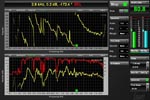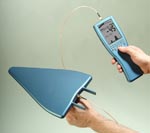Final Exam

- The wide availability of audio and acoustical test and measurement software and hardware has certainly made it easier for integrators to test a system before handing it over to the client. But sometimes it seems impossible to determine which measurements are right for the occasion.
- The following are just a few examples of tests that should be standard operating procedure for contractors operating in every genre of installation type. These are all decidedly very important, but the single most important audio test that should be performed on every system is the usually subjective, all-powerful, overwhelmingly definitive test of listening.
- Listen to your system. Listen to it with several different types of music. Turn it all the way up; turn it down until you can barely hear it. Does it sound good at all levels? When you listen to familiar recordings, are all the instruments where they are supposed to be panned in the mix? Do female voices sound beamy or hollow?
- Your ears should feel good after listening to a well adjusted audio system, and if they do, chances are your client will feel good as well!
- Signal to Noise Ratio: Adjust all system gain controls for optimum signal to noise ratio. After all adjustments required to meet specification requirements are made, measure and report the resulting system electrical signal to noise ratio at the amplifier outputs from 20 Hz to 20 kHz in octave bands.
- Translation: Make sure that there is little or no "hissing" sound in your audio system. You can do this by carefully adjusting the knobs that change the input sensitivity at each device in your signal chain.
- Equalization: Measure the sound pressure level in the listening area using a calibrated type one precision sound level meter as defined by ANSI Sl.4. Measurement should be made using the slow time constant. Report the unequalized house curve with the equalizer controls set to "0".
- Translation: Show your client how the system sounded before you adjusted those equalizers you sold him for $1,000.
- Coverage Uniformity: Scan the areas served by the system and perform any necessary adjustments as required to achieve coverage uniformity. Adjust any system equalizers to provide "flat" frequency response (+3 dB) throughout seating areas.
- Translation: Make sure that people seated in different areas of the audience all get about the same volume. You don't want to blow someone's ears out in certain areas, when people in other areas can't hear because the system isn't loud enough.
- Speech Reinforcement Equalization: Roll low frequencies off at 3 dB per octave below 200 Hz. High frequencies shall roll-off 3 dB per octave above 8.0 kHz. Adjustments are to be made using a calibrated type one precision sound level meter as defined by ANSI Sl.4. Document and report the equalized house curves for both speech sources and audio playback, and save settings as a preset on disk.
- Translation: Minimize your chances for feedback by limiting the amount of frequencies you have to work with to the range that contributes most to speech intelligibility.
- Marcel Schoenenberger, principal consultant, MCSquared Design Group, and Carlos Rivera, president, United Technology Service, contributed to this article.
Test & Measurement Products 2007
Sencore DA795 Digital Audio Analyzer
The DA795 digital audio analyzer is a multi-function, dual-domain, digital audio test instrument which provides a complete set of test, troubleshooting, and utility functions for digital audio analysis, in a hand-held DSP-powered device. Analyze any stereo digital audio signal, and generate low-noise digital test signals, all at up to 24 bit/96k sample rate resolution. Digital audio analysis features and functionality normally found only on expensive bench test equipment, now available in a portable, easy-to-use and cost-effective package.
EASE Focus
EASE Focus is a software that allows the modelling of acoustic sources, in particular line arrays, in two dimensions. It only considers the direct field, created by the complex addition of the sound contributions of the individual loudspeakers or array components. The design of EASE Focus is targeted at the end user, but also at the R&D engineer. Therefore great efforts are made to create an intuitive and consistent interface, that agrees with modern user interface design principles.

NTI AG RT-2X
An impedance matching network extends the analogue outputs for POTS testing, covering the international network requirements. Functional extension for measuring longitudinal balance completes the POTS testing requests. The ability to extend RT-2X with ISDN basic rate and E1/T1/J1 primary rate interfaces promotes the RT-2X to be a truely dual-domain Telecommunications analyzer, conducting all TX and RX tests (A-A, A-D, D-D, D-A). RT-2X is the complete test solution to verify the analog parameters of e.g. linecards with analog POTS- and digital T1, E1 or J1 access interfaces. RT-2X offers the full RT-2M functionality in a larger cabinet to include additional telecomunication testing options.

EAW Smaart v.6
Smaart v.6 performs dual-channel, FFT-based audio measurement in an intuitive, accessible interface that seamlessly integrates measurement, analysis, and data logging. It can also remotely control an extensive, constantly expanding list of professional equalizers and DSP processors.
Rebuilt from the ground up, Smaart v.6 features significantly modernized architecture to unleash the potential of the latest microprocessors and multitasking operating systems. Further, Smaart v.6 now runs native under both Mac OS X and Windows from the same unified source code.

Kaltman Creations HF4060 RF Spectrum Analyzer
The Spectran HF4060 covers the frequency range of 10 MHz to 6 GHz making it possible to view all RF activity from down around 70 MHz to 80 MHz for assisted listening devices through VHF and UHF, all the way up to 6GHz. On the higher frequencies, you can view RF activity for remote AMX and Crestron wireless control, Wi-Fi, intercom, etc. Just likes its counterparts--models HF4040, HF6060, and HF6080--the Spectran HF4060 features 10 users assignable hot keys for instant access to frequently used RF bands.
A daily selection of the top stories for AV integrators, resellers and consultants. Sign up below.
Ivie IE-35 Audio Analysis System
The IE-35 Audio Analysis System from Ivie is a second generation, calibrated, handheld audio instrument delivering a broad range of acoustical measurements displayed in color. In-the-field functions include real time analyzer measurements, sound pressure level measurements, seat-to-seat level variation measurements, strip chart recordings of sound level over time, polarity checking, oscilloscope measurements, noise criteria measurements, a built-in signal generator, audio level volt meter, RT60 reverb, and more.
